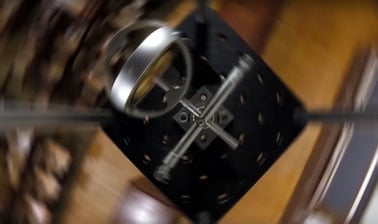The online pendulum simulations on this page show us in a practical way what the forces and energy acting on a pendulum are like.
Pendulums are physical systems consisting of a mass suspended from a fixed point that can swing back and forth. These systems are widely studied in physics and present interesting concepts related to force and energy.
he force acting on a pendulum is known as the restoring force, and is responsible for returning the pendulum to its equilibrium position. In the case of a simple pendulum, such as a thread with a mass at its end, the restoring force is provided by gravity. This force is directed towards the equilibrium point and is proportional to the angular displacement of the pendulum. It is governed by Hooke’s law, which states that the restoring force is directly proportional to the displacement and has opposite direction to the displacement.
The energy in a pendulum can be divided into two forms: kinetic energy and potential energy. As the pendulum swings, energy is transferred between these two forms. When the pendulum is at its highest point, all of its energy is potential energy because of the height at which the mass is located. As the pendulum descends, the potential energy is converted to kinetic energy as the mass gains speed. At the lowest point of the motion, all the energy is kinetic. As the pendulum ascends again, the kinetic energy decreases and becomes potential energy. This energy exchange continues as the pendulum swings back and forth.
The period of a pendulum, which is the time it takes to complete one full cycle of oscillation, depends on the length of the string and the acceleration due to gravity. A longer pendulum will have a longer period, while a shorter pendulum will have a shorter period. The relationship between the period (T) of a simple pendulum and its length (L) can be calculated using the formula:
T = 2π √(L/g)
Where g is the acceleration due to gravity.
Explore the exciting STEM world with our free, online simulations and accompanying companion courses! With them you'll be able to experience and learn hands-on. Take this opportunity to immerse yourself in virtual experiences while advancing your education - awaken your scientific curiosity and discover all that the STEM world has to offer!
- Forces I
- Forces II
- Energy I
- Energy II
- Lab I
- Lab II
Forces in a pendulum
In this simulation you can see the force diagram of a pendulum as it is pulled or pushed back and forth. Observe how equilibrium is reached between the three forces acting on the ball. In which position is the tension the least?
Forces in a pendulum II
This simulation allows us to observe the forces acting on a pendulum.
Energy in a pendulum
When the pendulum is released, it begins to swing back and forth. At what point are the maximum and minimum kinetic energy of the ball?
Energy in a pendulum II
The energy in a pendulum swings between potential and kinetic. Where has the energy of this pendulum gone?
Pendulum Laboratory
Play with one or two pendulums and discover how the period of a simple pendulum depends on the length of the chain, the mass of the pendulum, the force of gravity, and the amplitude of the oscillation. Observe the energy in the system in real time and change the amount of friction. Measure the period using the timer or stopwatch. Use the pendulum to find the value of g on Planet X. Observe the anharmonic behavior at large amplitude.
File
Physics courses


AP® Physics 1 – Part 1: Linear Motion



AP Physics 1



AP® Physics 1 – Part 2: Rotational Motion



AP® Physics 1: Challenging Concepts



Mechanics, Part 2



Mechanics, Part 1



Dynamics and Control

Other courses


Fat Chance: Probability from the Ground Up



Energy Within Environmental Constraints



Climate Change: The Science



Reservoir Geomechanics



Basic Steps in Magnetic Resonance



Greatest Unsolved Mysteries of the Universe



Modeling Climate Change



Introduction to Continuum Physics





















